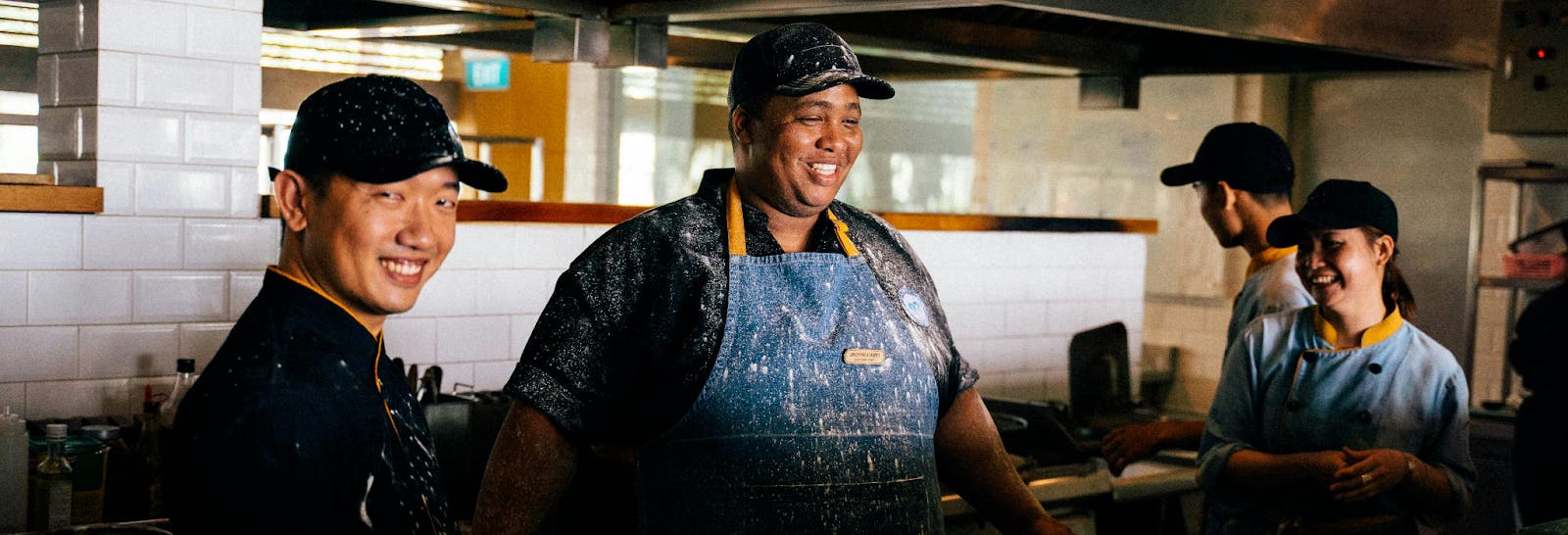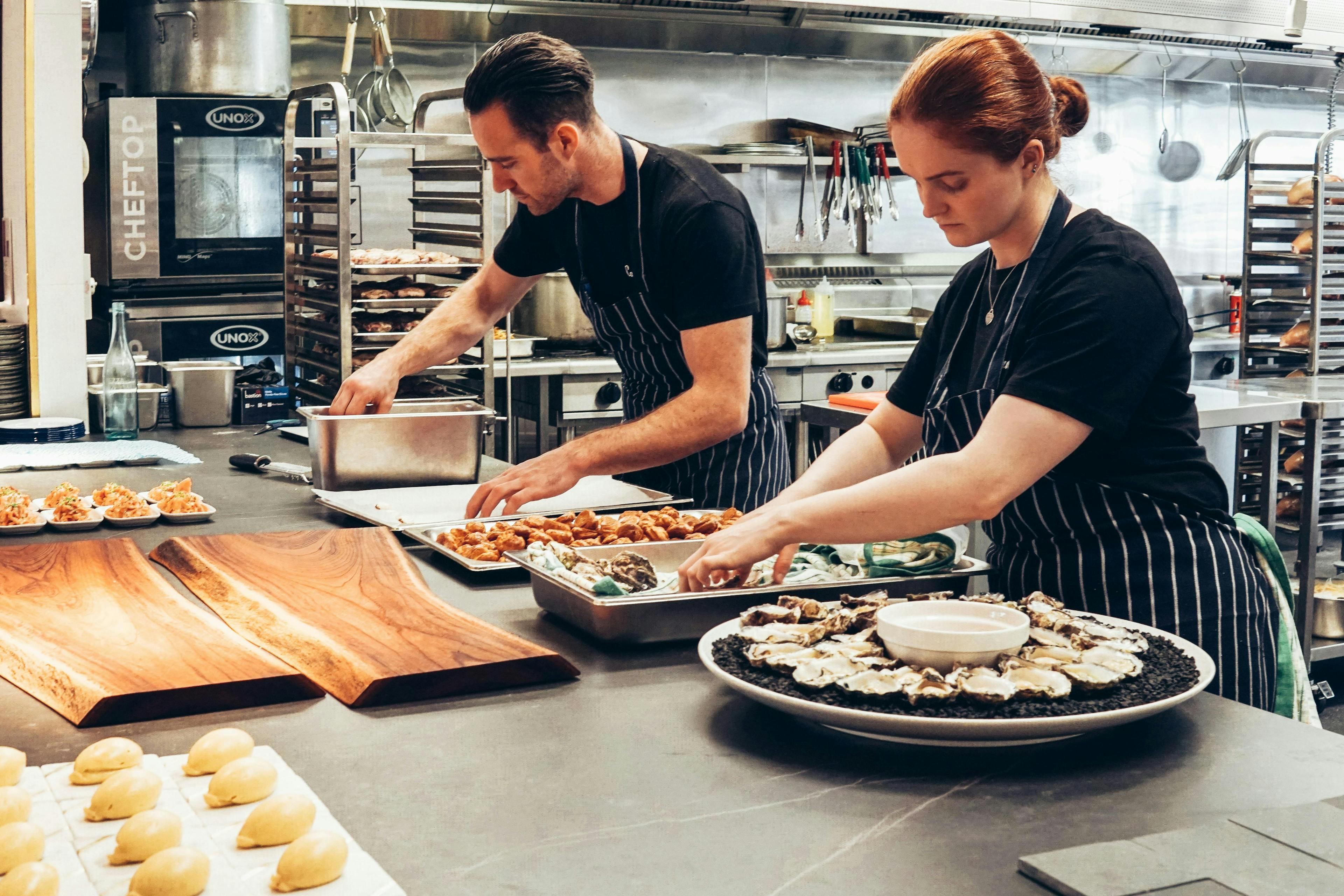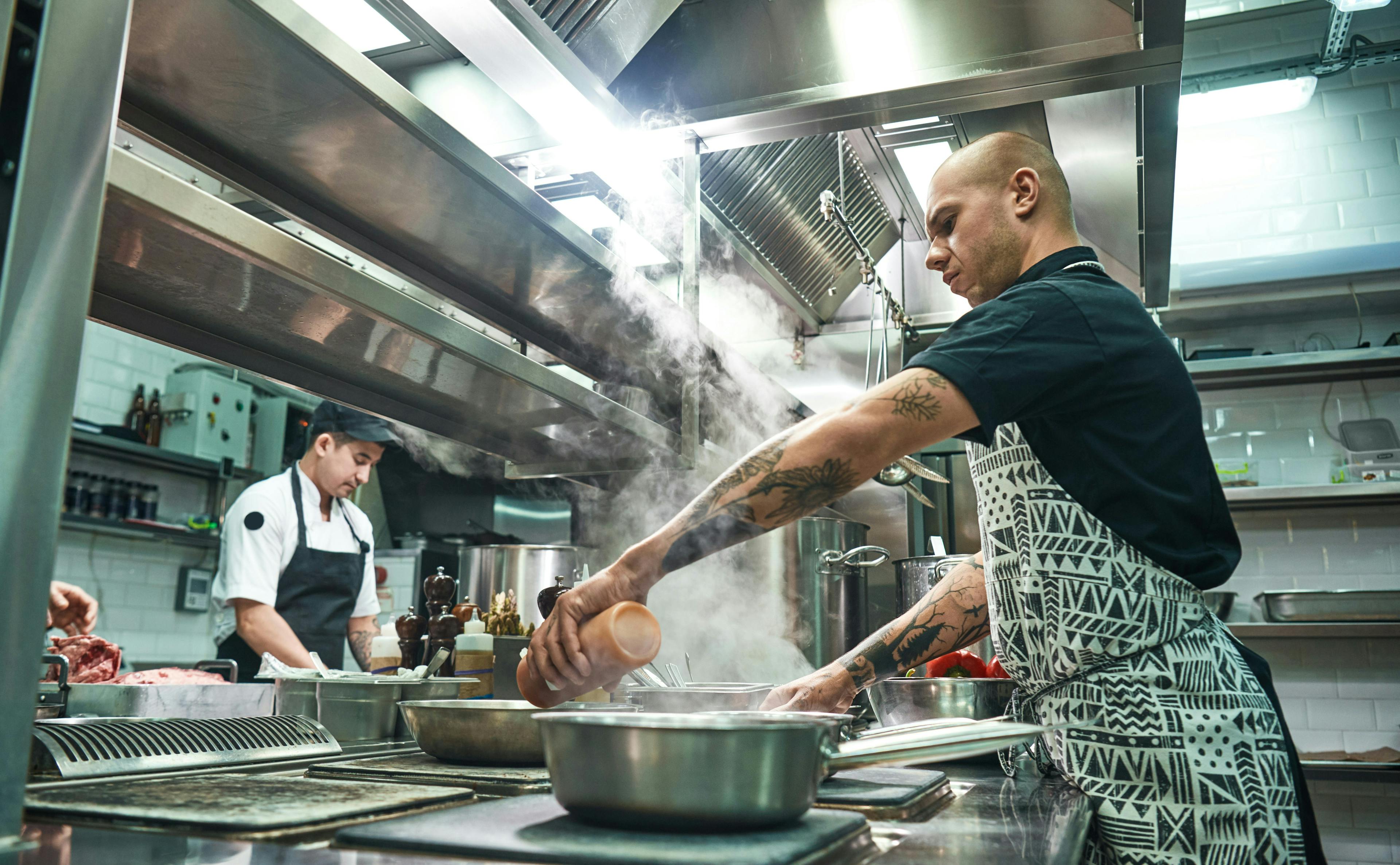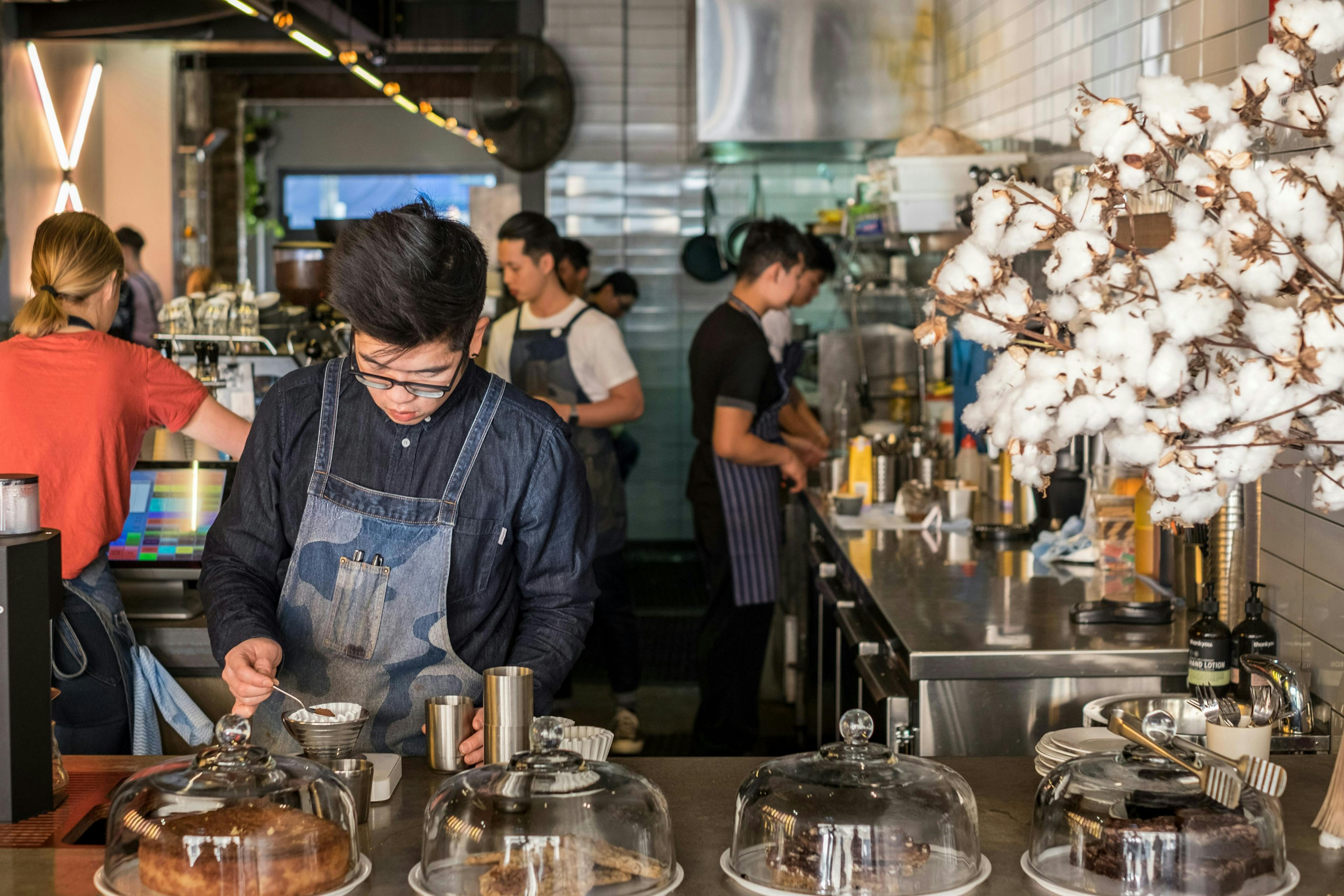
Here’s the scene: You’re sitting in a restaurant and the kitchen door swings open, and you hear the echoes of someone yelling “behind” while another shouts “Fire entrees for table 6!” You’ve heard things like that from restaurant staff (or on The Bear) before, but you’ve never quite known what they meant. The Otter team has put together the ultimate guide to restaurant slang, shorthand, and language below so you don’t have to wonder anymore.
Looking to upgrade your restaurant service and software? Schedule a call with Otter’s team!
First, let’s ask ourselves – why do people in the restaurant world use their own terminology? It can seem confusing, but it makes sense in context. A restaurant’s kitchen is a hectic place and time is of the essence – and speaking quietly in full sentences isn’t great for grabbing attention. Cooks, servers, hosts, and managers need a way to communicate rapidly and clearly so that no time (or money) is lost. Over centuries, restaurant staff have developed a verbal shorthand for a variety of situations to solve problems and share updates ASAP. Let’s find out what this shorthand is, and how to use it!
General restaurant terms

These are the baseline, foundational elements of the restaurant world’s unique language. If you’ve spent any time in the industry, you’ll likely have heard these terms used several times a day. They cover topics like standard restaurant equipment, typical kitchen roles, and the qualities of food being prepared. Most members of kitchen staff are trained in this shorthand when they first begin working in a restaurant. Use phrases like these to address general subjects at any time of service and in any part of your business.
- Walk-in: A kitchen’s refrigerator/freezer room that can be freely “walked into” to retrieve or store ingredients.
- Front-of-house: A restaurant’s dining area, which often contains a host section and a bar. This is the part of the restaurant that’s accessible to customers.
- Back-of-house: A restaurant’s kitchen, storage, and management space. This is where food is cooked and business operations are dealt with, and isn’t available to customers.
- Sous chef: The second highest-priority chef in the kitchen. Manages line chefs and certain sections of the cooking space, and assists the head chef.
- Chef de partie: French for “line cook”. This is a chef that controls a particular part of the kitchen’s cooking process, like grilling meat or cutting vegetables.
- Low boy: A small fridge or freezer unit that’s typically kept in the kitchen. Ingredients that can be retrieved and cooked immediately during service are stored here.
- Dying: A dish that has been completed by the kitchen team, but is still waiting to be served by a server. (Ideally, most dishes should be served immediately after plating.)
- Dead plate: A dish that has passed its point of freshness and should no longer be served. Kitchen staff will usually throw out and remake dishes like these.
- On the line: Food that is currently being cooked by kitchen staff. As the dish progresses through each stage of completion, it moves through “the line”.
- Shelf life: How long a particular ingredient remains fresh and available to be cooked. When “shelf life” expires, the ingredient is disposed of.
Kitchen staff terms

This is the language you’ll hear used by people working in a restaurant’s kitchen during service. The words and phrases listed here are appreciated for their ability to impart information immediately, which is necessary during service. Most of this shorthand relates to commands being given by a high-ranking chef and acknowledged by their assistants. Typically, these terms describe the preparation of a dish, and are monitored by waitstaff to determine a certain item’s readiness. Use this lingo when you’re sharing updates about kitchen activities.
- Yes, chef!: A kitchen staff member’s response to a command from their chef. The person giving this response will be performing the action they’ve been told to.
- 86: A command given to signal when an ingredient has run out and a dish can no longer be made. Some dishes can be “86”ed permanently.
- Out: Confirmation from the kitchen staff to the waitstaff that a certain dish has been completed and is ready to be served.
- Hands: A term shouted by the expeditor when a dish is ready to be brought to a table. Anyone who has available “hands” drops what they’re doing and serves the food ASAP.
- On the fly: An order made by a customer that’s introduced to the kitchen immediately and takes top priority. Dishes made “on the fly” are cooked and served quickly.
- On deck: An order that has been received by a server and is awaiting preparation from the kitchen staff. Food “on deck” moves to “the line” when cooking begins.
- Behind: A kitchen staff member who is currently moving behind another one. This word is said so that no one bumps into anyone.
- Fire: A command given to begin cooking a dish. This command is given by an expediter to a head or sous chef.
- Drop: A command given to begin cooking a component of a dish, typically a side. This command is given by a head or sous chef to a chef de partie.
- Marry: A command to combine two elements of a dish, like a main and a side, or two ingredients during the cooking process. This is also used for condiments at times – if there are two half-full ketchup bottles, you can “marry” them into one.
- Refire: A command given to begin remaking a dish, often after it’s been sent back by a customer due to an issue. Given by an expediter to a head or sous chef.
Restaurant management terms

The following are a list of terms that keep the front- and back-of-house communication running smoothly to ensure all orders are completed. You’ll hear these phrases spoken by staff members who need to move across the restaurant quickly and manage several employees. Servers and cooks alike understand this language, and use it to guide their activities before and during service.
- Run the dish: Used to confirm that a dish has finished cooking and is ready to be served to the table by a server.
- Stretch it: A command given to a chef requesting that a certain ingredient be used as much as possible to maximize efficiency.
- Expedite: The act of calling out an order to the kitchen staff, beginning the cooking process. An employee who does this is called an expeditor.
- Pass: The part of the kitchen where completed orders are placed by cooks to be received and served by waitstaff. (Sometimes called the “expo station”.)
- Mise en place: The plating of a dish – how its cooked ingredients are arranged and presented when served to the customer.
- Ticket: A written (or digital) order taken by a server and given to the expeditor. This order is then called out to the kitchen staff, and the ticket is saved for future reference.
- À la minute: French for “in a minute”, meaning “made to order”. A dish that is cooked only when an order for it has been received, without significant preparation time.
- The Board: The area of a kitchen where written tickets are held for reference by an expeditor, server, or kitchen staff member.
- Covers: The total number of customers at a table or in the dining room. A table with two “covers”, for example, has two customers currently dining.
- Floor: The dining room, used during active service to confirm that customers are being attended to. (Also used for waitstaff organization to designate certain areas.)
Restaurant tech terms

Times may have changed, but restaurateurs’ dedication to using short, understandable slang certainly hasn’t! These phrases refer to pieces of technology that are common in today’s digitally-empowered restaurants and the greater online food landscape. Most people in the modern restaurant industry, regardless of whether they’re involved in a kitchen, are aware of this language. You’ll also see it used commonly on digital restaurant ordering platforms, where it identifies certain features or services.
- POS: Short for Point-Of-Sale system. The central piece of restaurant equipment that manages orders, staff, revenue, and a variety of other key information.
- Delivery app: A mobile or web application that lets customers order food online and have it delivered directly to their homes – Uber Eats, DoorDash, SkipTheDishes, etc.
- Delivery commission: The fee that a restaurant owner pays to a delivery app provider to use their service. Typically a component of every sale made through online delivery.
- Order management: The process of accepting, organizing, and completing orders digitally through a piece of restaurant order management software.
- Virtual brand: A digital restaurant storefront that serves customers entirely through delivery apps, usually run by real-world restaurants alongside their existing business.
- Menu management: A system for creating and updating digital menus across multiple real-world and online storefronts.
- Dine-in: Traditional tableside service that takes place entirely within a single physical restaurant. Customers place orders, receive food, and dine at their tables.
- QR ordering: A method of placing orders that uses QR codes to show digital menus which customers can interact with using their mobile devices.
- Online ordering: Restaurant orders placed through a web platform that are then delivered, picked up, or served in-house upon the customer’s arrival.
- Dashboard: A “hub” screen on a digital POS platform that lets restaurant owners and staff view multiple orders, menus, and pieces of data in one place.
Start speaking the language of restaurant success!

By using the terms we’ve listed here, you’ll be able to communicate with a variety of restaurateurs throughout the industry! Of course, strong communication takes more than just some shorthand. Experience in the restaurant landscape and a firm understanding of what staff and customers demand is critical. The best way to understand restaurant slang is to engage with the people who speak it every day. Once you do, you’ll be able to connect with any kind of restaurant worker, and keep your kitchen coordination strong.
Empower every member of your restaurant’s team with Otter’s new POS. Book a demo with Otter today!

Book a demo to see how Otter’s all-in-one platform can help your restaurant thrive.